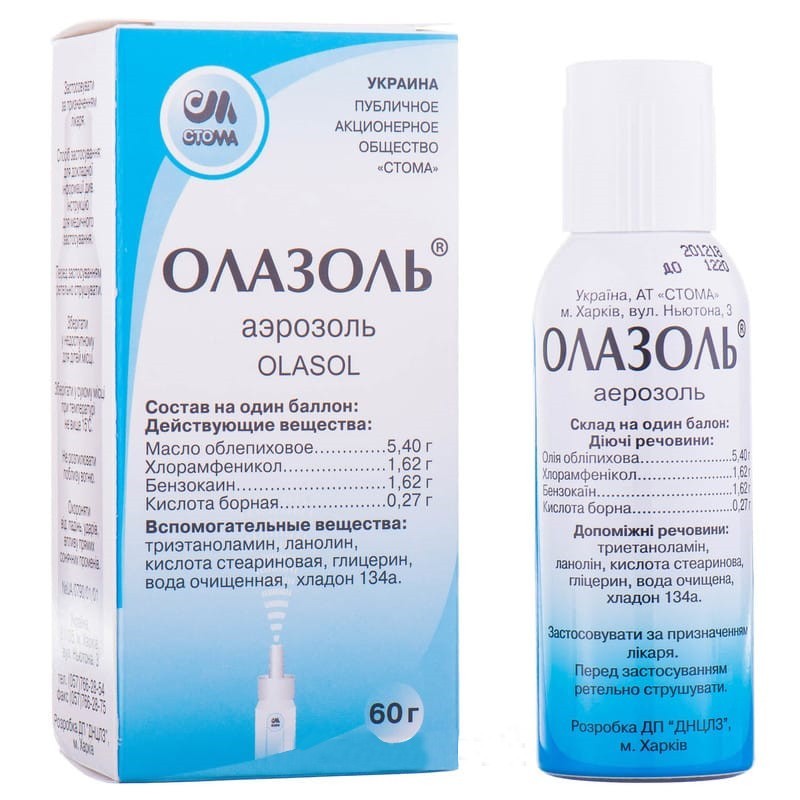



 Secure and encrypted payment processing
Secure and encrypted payment processing We ship to over 40 countries including the USA, UK, Europe, Australia and Japan
We ship to over 40 countries including the USA, UK, Europe, Australia and Japan Guaranteed refund or reship if you haven't received your order
Guaranteed refund or reship if you haven't received your orderAerosol "Olazol®"It is recommended to apply:
1 cylinder contains (active substances):
Excipients: triethanolamine, lanolin, stearic acid, glycerin, purified water, HFC 134a.
Shake the aerosol can 10-15 times before use, remove the protective cap, put the spray nozzle on the valve stem and slowly press on its head, as a result of which the drug leaves the balloon in the form of foam. Before and after applying the medicine, the spray nozzle must be washed with boiled water.
For external use. If possible, clean the wound surface from pus, necrotic tissue and cover it with a uniform layer (1-1.5 cm) of foam. Apply daily or every other day, with open treatment of wounds and burns in adults - 1-4 times a day, in children from 2 years old - 1-2 times a day, depending on the nature of the inflammation and the stage of regeneration of damaged tissues. To cover the entire wound surface, apply foam from a distance of 1-5 cm. Press the spray nozzle head all the way and immediately release it - 7 ml of foam (approximately 1.4 g of the drug) is released from the balloon, which is enough to cover the wound with a surface area of about 100 cm2. The duration of treatment is determined and controlled by the doctor individually.
When applied to the cavity. For gynecological diseases (bacterial vaginosis, cervical erosion), before administering the drug to the vagina in order to remove mucus, douche with an antiseptic solution (chamomile broth or Furacilin 1: 5000, chlorhexidine bigluconate 0.02%, sodium bicarbonate 2%). After that, enter the free edge of the spray nozzle into the vagina to a depth of 1.5-2 cm, press its head until it stops and immediately release it. For gynecological diseases, repeat the procedure 2 times a day. The course of treatment is 7-10 days.
With proctitis, first make a cleansing enema with a decoction of chamomile or calendula, then enter the free edge of the spray nozzle into the rectum to a depth of 2-4 cm, press its head until it stops and immediately release it. The procedure is carried out 1 time per day. The course of treatment is up to 2 weeks.
The drug should not be used during pregnancy or lactation.
Apply externally to children from 2 years. Treatment should be carried out under the supervision of a physician. There is no experience with the use of gynecology and proctology in children, therefore, the drug should not be used in children according to these indications.
The ability of the drug to influence the reaction rate when driving vehicles or other mechanisms has not been established.
External use of the drug in recommended doses does not cause an overdose.
Long-term and frequent use of drugs containing chloramphenicol can lead to contact sensitization, which is accompanied by the development of hypersensitivity reactions during the subsequent use of the drug externally or in the form of dosage forms for systemic use.
Overdose symptoms during systemic absorption of benzocaine can occur: drowsiness, anxiety, heart rhythm disturbances, agitation. In severe cases - convulsions, coma, decreased respiratory rate or respiratory failure. There are reports that the use of drugs containing benzocaine caused methemoglobinemia. Symptoms such as cyanosis of the skin, lips, and nail beds, headache, dizziness, shortness of breath (difficulty breathing), weakness, and tachycardia, which may occur during treatment, may indicate methemoglobinemia, which is potentially life-threatening and requires urgent medical attention. Emergency care in case of overdose and the development of methemoglobinemia consists in the intravenous administration of methylene blue.
Overdose symptoms during systemic absorption of boric acid can occur: nausea, vomiting, diarrhea, circulatory disorders and depression of the central nervous system, decreased body temperature, shock, coma, erythematous rash. In case of severe poisoning, measures are taken to maintain the vital functions of the body, hemodialysis or peritoneal dialysis, replacement blood transfusion are performed. With prolonged use of the drug in large areas of the skin, symptoms of chronic intoxication may occur: tissue edema, exhaustion, stomatitis, eczema, menstrual irregularities in women, anemia, convulsions, alopecia.
Overdose symptoms require discontinuation of the drug and symptomatic treatment.
Local reactions: slight temporary (2-3 minutes) increased discomfort in the anal area after administration of the drug.
From the immune system: allergic reactions are possible, including Quinckes edema, other signs of irritation that were not observed before treatment, skin rashes, itching, burning sensation, hyperemia, edema. Prolonged external use often leads to contact sensitization.
From the gastrointestinal tract: urge to defecate, dyspeptic symptoms (nausea, vomiting, loose stools) are possible; in these cases, the use of the drug should be discontinued.
From the hemopoietic system: leukopenia, thromobocytopenia, reticulocytopenia, decreased hemoglobin in the blood.
Store in the original packaging at a temperature of + 2 ° C to + 8 ° C, out of the reach of children.
Shelf life is 2 years.